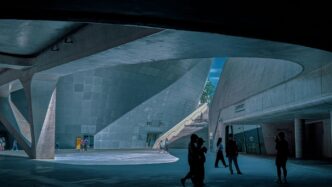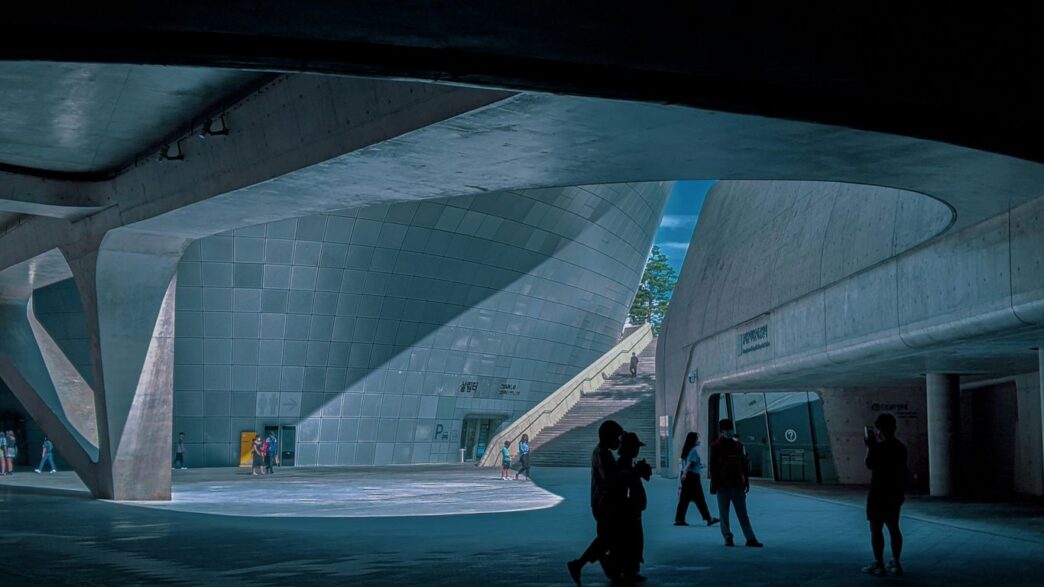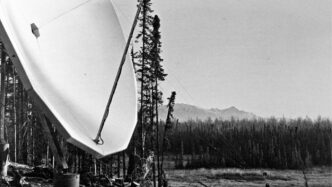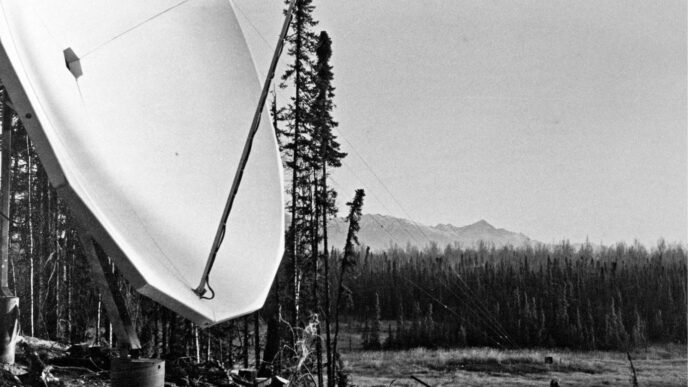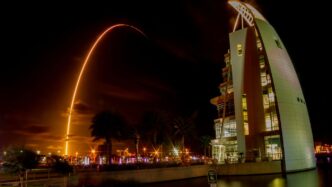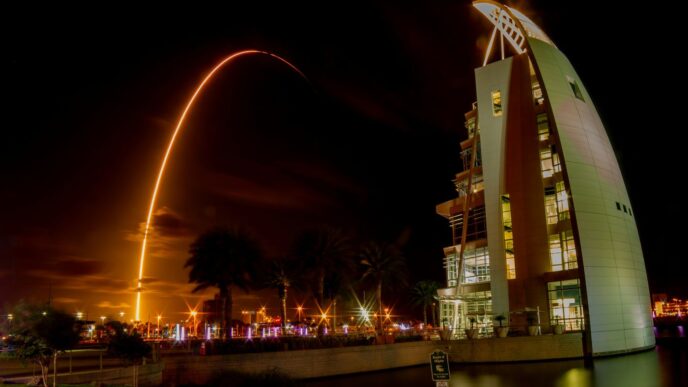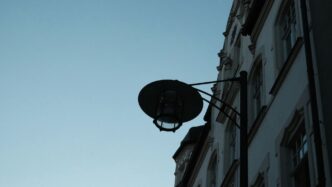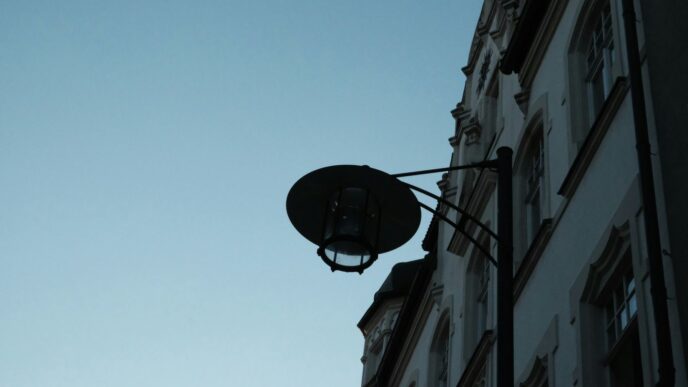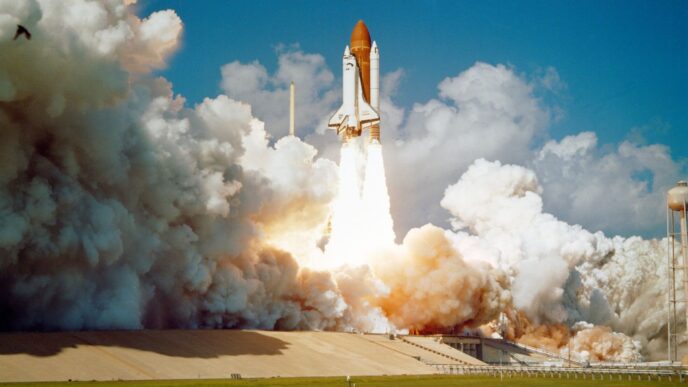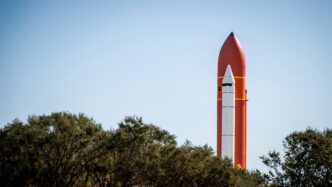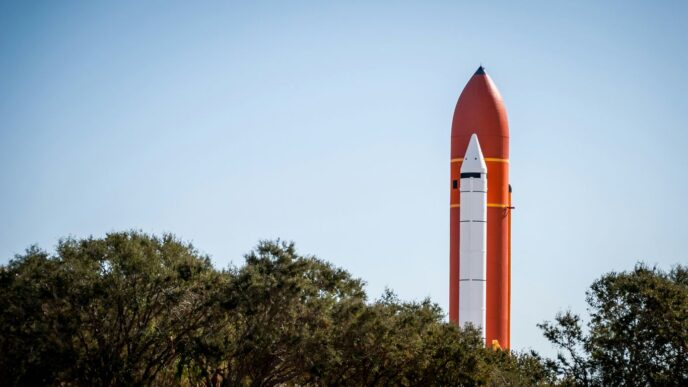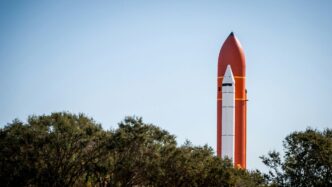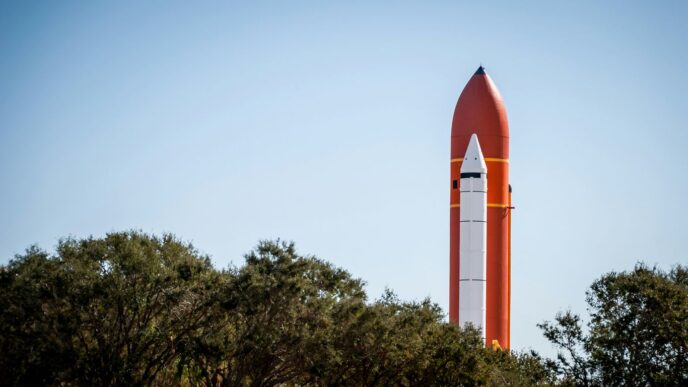The Alien movies have given us some truly unforgettable ships. From gritty freighters to military vessels, these alien movie spaceships are a big part of what makes the universe feel so real. Let’s take a closer look at some of the most iconic ones.
Key Takeaways
- The USCSS Nostromo, a commercial hauler, set the tone with its industrial, retro-futuristic design, making it a memorable part of the first film.
- The USS Sulaco represents the military might of the Colonial Marines, designed for conflict and troop transport, a stark contrast to the Nostromo.
- Weyland Corp’s USCSS Prometheus was a cutting-edge scientific vessel, showcasing advanced technology for exploration missions.
- The USCSS Covenant’s Lander, a dropship, was vital for planetary exploration, equipped for both scientific and medical needs.
- The UD-4 ‘Cheyenne’ Dropship is a versatile vehicle, a common sight for Colonial Marine operations on hostile worlds.
The Iconic USCSS Nostromo: A Hauntingly Familiar Freighter
When you think of the original Alien movie, one of the first things that probably pops into your head is the ship. The USCSS Nostromo. It’s not some sleek, futuristic vessel; it’s more like a beat-up, industrial workhorse. This freighter, owned by the Weyland-Yutani Corporation, was built by Lock-Mart Industries and designed to haul massive cargo containers, essentially acting like a space tug. Instead of carrying goods inside, it would latch onto and pull them. Its main job was moving automated refineries and ore between Earth and the outer colonies. It’s this gritty, lived-in feel that makes it so memorable, a far cry from the pristine ships you often see in sci-fi.
A Commercial Hauler’s Humble Beginnings
The Nostromo wasn’t built for combat or fancy exploration. It was a commercial freighter, a CM-88B Bison M-Class star freighter, to be exact. Its purpose was purely utilitarian: to get the job done, no matter how dirty. Think of it like a long-haul truck of space, chugging along through the void, pulling its massive loads. This grounded approach to its design really helped make the universe of Alien feel more real and relatable, even with the terrifying creature lurking onboard.
The Narcissus: A Tiny Escape Pod’s Legacy
While the Nostromo itself met a fiery end, a small part of it survived. The Narcissus, a tiny escape shuttle, became Ellen Ripley’s only hope. It was a small, cramped vessel, but it carried Ripley and the cat, Jones, away from the horror. This little shuttle, though overshadowed by the main ship, plays a huge role in the story, representing survival against all odds. It’s a stark contrast to the Nostromo’s industrial bulk, a symbol of hope in the darkness.
Retro-Futuristic Design and Industrial Aesthetics
The Nostromo’s look is what really sets it apart. It’s got this amazing retro-futuristic vibe. Everything looks functional, a bit clunky, and very used. You can see the pipes, the exposed wiring, the wear and tear. It feels like a real working ship, not just a prop. This industrial aesthetic, with its muted colors and utilitarian layout, contributes a lot to the film’s unsettling atmosphere. It’s a ship that feels like it belongs in the gritty future, a place where even space travel is a blue-collar job.
The Mighty USS Sulaco: A Colonial Marine Warship
When you think of the Colonial Marines in the Alien universe, one ship immediately comes to mind: the USS Sulaco. This isn’t some rusty freighter or a sleek science vessel; the Sulaco is a Conestoga-class troop transport, built for one thing – military operations. Manufactured by Lunnar-Welsun Industries, it’s a beast of a ship, designed to carry a full combat unit across the vastness of space. Its imposing silhouette, a stark contrast to the Nostromo’s utilitarian design, immediately signals a shift from survival horror to military action.
Troop Transport and Military Might
The Sulaco’s primary role was moving troops and equipment. It served as the mobile base for the Colonial Marines sent to investigate the distress call from Hadley’s Hope on Acheron in 2179. Imagine this massive vessel dropping off squads of heavily armed soldiers onto a hostile planet – that’s the Sulaco’s bread and butter. It’s equipped to handle the rigors of deep space deployment and planetary assault, making it a symbol of Weyland-Yutani’s military reach.
A Design Forged in Conflict
James Cameron envisioned the Sulaco not as a smooth, rounded shape, but as a more industrial, almost aggressive form. The idea was a ‘forest of antennae’ leading into the ship’s massive bulk, giving it a distinct, almost menacing presence. This design choice helped tie it into the gritty, lived-in feel of the Alien universe, even as it represented a more advanced military presence. It’s a ship that looks like it’s seen action, and according to its history, it has. It even had a bit of a rough reputation, having sustained damage on previous missions and suffering from an accident during docking that sadly cost lives.
Navigating the Perils of Space
While the Sulaco is a warship, it’s still a vessel operating in the dangerous void of space. It carries the Colonial Marines, but it also carries the means for their deployment and support. This includes the iconic UD-4 ‘Cheyenne’ dropships, which are launched from the Sulaco’s hangar bay. The ship itself is a testament to the technological advancements Weyland-Yutani made in military space travel, a far cry from the commercial haulers that came before it. Its design prioritizes function and survivability in hostile environments, making it a believable and formidable presence in the Alien saga.
USCSS Prometheus: Weyland Corp’s Scientific Vanguard
The USCSS Prometheus stands out as a significant leap in Weyland Corp’s starship design. Unlike the utilitarian, almost grimy feel of the Nostromo, the Prometheus was built with a singular purpose: scientific exploration at the furthest reaches of known space. This vessel represented the pinnacle of Weyland Corp’s ambition and technological prowess at the time. It was a state-of-the-art exploration ship, designed to carry a large crew of scientists and specialists on missions of discovery.
Cutting-Edge Exploration Vessel
The Prometheus was a Heliades-class J scientific exploratory vessel, and it was a big deal when it first launched. It was the first human spacecraft capable of faster-than-light travel, which really opened up the galaxy. The ship itself is quite striking, with four powerful nuclear-powered ion plasma engines that gave it VTOL capabilities. Inside, it was equipped to handle long-duration missions, featuring hypersleep chambers for the crew and even escape modules, just in case things went south. It also had a massive hangar bay, capable of holding over 20 different vehicles, which really speaks to the scale of its exploratory mandate. It’s a stark contrast to the older, more industrial ships we saw earlier in the franchise. You can see how Weyland Corp was really pushing the boundaries with this ship, especially considering Peter Weyland himself was on board for the mission to LV-223. It makes sense that they’d want their best ship for such an important expedition.
Advanced Technology for a Crucial Mission
This ship was packed with tech. It had advanced communication arrays, similar to those on the Nostromo, but likely with greater range and capability. The Prometheus also boasted an advanced MedPod, a sophisticated medical facility that could handle a wide range of emergencies. The sheer amount of equipment and vehicles it carried highlights its role as a mobile research station.
Here’s a look at some of its key features:
- Propulsion: Four nuclear-powered ion plasma engines with VTOL.
- Capacity: Space for a large scientific crew, plus over 20 vehicles.
- Support Systems: Hypersleep chambers, escape modules, advanced MedPod.
- Manufacturer: Weyland Corp.
A Stark Contrast to Earlier Designs
When you look at the Prometheus next to, say, the USCSS Nostromo, the difference is pretty obvious. The Nostromo felt like a working-class freighter, built for hauling and with a design that reflected its industrial purpose. It had that lived-in, retro-futuristic look. The Prometheus, on the other hand, is sleek, modern, and clearly built for cutting-edge science. It’s like comparing a beat-up pickup truck to a brand-new, high-tech research submarine. This difference in design really tells a story about Weyland Corp’s priorities and the different kinds of missions they were undertaking. While the Nostromo was about getting the job done, the Prometheus was about pushing the boundaries of human knowledge, a mission that ultimately led to some very dark discoveries on LV-223. The ship itself was a product of Weyland Corp’s drive for progress, a drive that [e8ff] was already evident in their earlier ventures.
The USCSS Covenant’s Lander: Essential for Planetary Exploration

When we think about the big ships in the Alien universe, we often focus on the massive carriers like the Nostromo or the Sulaco. But the USCSS Covenant’s Lander, a Class E shuttle, really gets a lot of screen time and plays a big part in the story of Alien: Covenant. It’s not just a taxi to get people from orbit to the ground; Weyland-Yutani built these things to be pretty capable.
Weyland-Yutani’s Advanced Dropships
These aren’t your average shuttles. Weyland-Yutani, by the time the Covenant set out in 2104, was a pretty big deal, and they equipped their landers with more than just basic flight controls. They were designed with advanced capabilities, especially for medical needs and other delicate operations. Think of them as versatile workhorses for exploration.
Designed for Medical and Scientific Missions
The Lander One, which is the one we see most in the movie (even though it’s marked ’02’ – a bit of a head-scratcher, maybe a nod to its lost sibling or just a mistake), had a lot packed inside. It could carry a pilot, a co-pilot, and up to ten passengers. But beyond that, there was room for cargo, equipment, a dedicated payload bay, and, importantly, an advanced med bay. This suggests Weyland-Yutani expected things to go wrong and wanted to be prepared for anything from minor injuries to serious medical emergencies.
The Fate of Lander Two
Sadly, not all of Weyland-Yutani’s landers made it. Lander Two met a rather unfortunate end before the events of the movie. It was destroyed in a collision with a shuttle piloted by a group called Earthsavers. These folks were pretty extreme, believing that alien monsters would destroy Earth and trying to stop any ships from leaving the planet. It’s a grim reminder of the dangers out there, even before you encounter any xenomorphs.
Here’s a quick look at what the Lander One could carry:
- Crew Capacity: 1 Pilot, 1 Co-Pilot
- Passenger Capacity: Up to 10
- Key Features: Cargo space, Equipment storage, Payload bay, Advanced Med Bay
The UD-4 ‘Cheyenne’ Dropship: A Versatile Aerial Vehicle
Graceful Descent to Hostile Worlds
The UD-4 ‘Cheyenne’ dropship is a real workhorse in the Colonial Marine Corps’ arsenal. You see it a lot in Aliens, usually ferrying troops and their gear to the surface of some hostile planet. It’s designed for quick deployment, kind of like a military helicopter but way more advanced. This dropship is pretty much the backbone of getting Marines from a big ship like the USS Sulaco down to where the action is. It’s built to handle tough landings and takeoffs, even in bad conditions.
Integral to Colonial Marine Operations
When you think about the Colonial Marines, you can’t help but picture the Cheyenne. It’s not just for transport, though. This thing is armed to the teeth. Depending on the mission, it can be fitted with all sorts of weapons. We’re talking heavy cannons, rocket pods, and missiles. It’s meant to provide fire support for the troops on the ground, making sure they have backup when things get hairy. It’s a pretty intimidating sight, honestly.
Here’s a look at some of its typical loadouts:
- Troop Transport: Carries a squad of Marines and their equipment.
- Fire Support: Equipped with various weapon systems for ground engagement.
- Armored Carrier Transport: Capable of carrying vehicles like the M577 armored personnel carrier.
It’s a versatile craft, and you can find models of the UD-4L Cheyenne Dropship if you’re a fan of the movie’s hardware. It really shows how much thought went into making the military side of the Alien universe feel real and functional. It’s a design that’s stuck with fans for a reason.
Exploring the Blueprints of Alien Movie Spaceships
You know, it’s one thing to see these amazing ships on screen, but have you ever stopped to think about how they were actually put together? It’s like looking at a really cool old car – you see the shiny paint, but then you start wondering about the engine, the chassis, all that stuff underneath. Well, the same goes for the spaceships in the Alien movies. They’ve got this gritty, used-up look, right? Like they’ve actually been out there, hauling cargo or fighting aliens, not just some shiny prop.
A Deep Dive into Design and Construction
It turns out, a lot of thought went into making these vessels feel real. Artists and designers didn’t just draw pretty pictures; they had to figure out how these things would actually work, or at least look like they would. They looked at old industrial designs, real-world factories, and even old ships to get that lived-in feel. It’s this attention to detail that makes the Nostromo feel like a real working freighter and the Sulaco like a proper military vessel. They weren’t just designing spaceships; they were designing entire worlds, piece by piece.
Reverse-Engineering Iconic Vessels
Think about it: the creators had to take what we saw on screen – maybe just a glimpse of a corridor or the outside of a ship – and then build out the rest. They had to imagine the engine rooms, the crew quarters, the cargo bays. It’s like being a detective, but instead of solving a crime, you’re figuring out how a spaceship is laid out. They’d look at concept art, set photos, and then try to piece together the whole puzzle, making sure it all made sense with what we saw in the movies. Sometimes, they even had to invent details for areas we never saw on camera.
The Art of Creating Believable Technology
So, what does it take to make a spaceship blueprint? It’s more than just drawing lines. You’ve got to consider:
- Functionality: How would this part actually work? Even if it’s just for show, it needs to look like it has a purpose.
- Scale: How big is this thing, really? Does it fit with the other ships and environments?
- Wear and Tear: Real machines get old and beat up. Adding details like rust, dents, and worn-out panels makes them look like they’ve been through a lot.
- Internal Layout: Where do the people go? Where’s the engine? Where’s the cargo? This stuff matters for making the ship feel like a place, not just a shape.
It’s a whole process of taking something that looks cool on screen and figuring out the nuts and bolts, making it feel like it could actually exist out there in the dark of space.
The Enduring Legacy of Alien’s Starships
So, there you have it. From the grimy, working-class feel of the Nostromo to the sleek, military might of the Sulaco, and even the more advanced, yet ultimately doomed, Prometheus and Covenant, the ships in the Alien universe are more than just backdrops. They’re characters in themselves, shaping the stories and adding to that gritty, lived-in sci-fi feel we’ve come to love. It’s pretty cool how each film brings its own unique take on space travel, but still manages to feel like it belongs in the same universe. These vessels, whether hauling ore or carrying marines, have really stuck with us, haven’t they? It makes you wonder what kind of ships we’ll see in future installments, but one thing’s for sure: they’ll probably be just as memorable.
Frequently Asked Questions
What is the most famous spaceship in the Alien movies?
The USCSS Nostromo from the first Alien movie is probably the most famous. It was a big, tough freighter that looked like it was used for hard work, not fancy trips. Its design really stuck with people and made the movie feel real, even though it was set in space.
What was the purpose of the USS Sulaco?
The USS Sulaco was a military ship, like a warship for space marines. Its main job was to carry troops and equipment to dangerous places, like the colony in Aliens. It was built for fighting and survival, looking much tougher than the Nostromo.
How was the USCSS Prometheus different from older ships?
The USCSS Prometheus was a super advanced science ship. It had the latest technology for exploring new worlds and was designed to be very high-tech and sleek. This was a big change from the older, more industrial-looking ships like the Nostromo, showing how much Weyland Corp had advanced.
What was the role of the USCSS Covenant’s Lander?
The Lander from the USCSS Covenant was a smaller ship used to travel from the main ship down to planets. It was designed to be safe and equipped for medical and scientific tasks. It was important for getting the crew to the surface for their missions.
Why are the ship designs in Alien so memorable?
The ship designs are memorable because they feel real, like they’ve been used a lot. They often have a ‘lived-in’ look, with industrial details and a sense of practicality. This makes the futuristic technology seem more believable, even when things go wrong.
What is ‘Alien: The Blueprints’ book about?
It’s a book that shows all the detailed drawings, called blueprints, of the spaceships, vehicles, and places from the Alien movies. It helps you understand how these amazing machines were designed and built, going deep into the engineering and art behind the sci-fi world.

